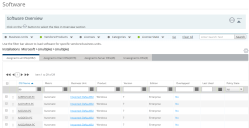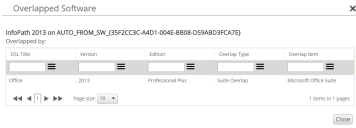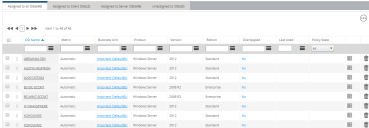Software
Software information is a key component of License Optimizer. You can either import Software information into License Optimizer or add it manually. For information on how to import software data, see Importing data.
To view software records:
1.Click Software under Estate Management on the menu bar.
The Software page appears. Initially, this page is blank.
2.Use the filter bar towards the top of the page to select the Business Units, vendors and products, license types, software categories, or license states that you are interested in.
The page updates to show four tabs, which you can search or filter.
IMPORTANT: Always use the filter bar to limit the list of software that is displayed to be only the items that you are interested in, as this will greatly improve the performance of the data grid. There are also filters available for each column on the data grid, but these filters work much more slowly on large data sets.
Shows software that is installed on OSIs that have an operating system that DOES NOT have the Server Software check box selected in the Software Library.
Shows software that is installed on OSIs that have an operating system that has the Server Software check box selected in the Software Library. You can use this tab to identify where client software has been installed on servers.
Software records listed in the Unassigned to OSIs tab have no OSI associated with them. However, these records are still used in reconciliation. You can use the Unassigned to OSI functionality to capture summary software liability that you don't want to create manually or can't import (for example, if you can't get data from beyond a firewall).
The gears menu options for the Unassigned to OSIs tab enable you to Add, Edit, Duplicate, or Delete Unassigned to OSI software records.
When using the Unassigned to OSIs functionality, consider whether the software data being created would be more appropriate for the Resource Usage page or the Software Users page. For more information on these pages, see Resource Usage or Software Users.
Unlicensed software
Sometimes, you want to identify when software that does not require a license has been installed in your estate. For example, you might want to discover when certain unlicensed software that you consider to be a security risk has been installed, or you might want to ensure that freeware that is not allowed to be used in a corporate environment has not been installed.
Set the License State filter to Licensed to see the unlicensed software in your estate that matches the other filters. The default setting for this filter is Licensed, which is also the value that is set if you click Clear All on the filter bar.
Overlapped software
The Overlapped column in the Software grid displays Yes or No hyperlinks for each listed product. Click a Yes link to see a list of all the software overlapped by a product.
The Overlap Type can be a downgrade, suite, or bundle. The Overlap Item is the name of the path, bundle, or suite.
Software usage
Some discovery tools, such as Ivanti Endpoint Manager, include usage information in the data that they provide to License Optimizer. If your data comes from a source such as this, you can use fields on the Software page to identify installed software that is not being used, and potentially uninstall it and then reclaim the licenses.
By default, the Last Used column is visible in the data grid, which enables you to determine when the software was last started on that OSI. From the Columns item on the ![]() menu, you can also add Launch Count and Minutes Used, which enable you to see how often the software was started and how long it has run for.
menu, you can also add Launch Count and Minutes Used, which enable you to see how often the software was started and how long it has run for.
Policy State
The Policy State column in the Software grid identifies software records that have been flagged by a policy. You can create a policy to identify software that is Unapproved, Approved or Mandatory. For more information on Policy, see Policy management.
Displaying extended fields in the Software grid
The Software grid displays information about software records. However, for some products you need to store information that is relevant only to that product. Fields that are relevant to only some products are called extended fields and are not included in the default field list, as it would make the list too large to manage.
When a record has an extended field associated with it,  appears in the software grid.
appears in the software grid.
To display extended fields, click  in the Software grid then select the check boxes for the required extended fields. You can hide or display it by right clicking the column heading as with other data grid columns.
in the Software grid then select the check boxes for the required extended fields. You can hide or display it by right clicking the column heading as with other data grid columns.
Where a software record has extended fields, you can view or amend the data in these fields by selecting the required record and choosing Edit from the Software page gears menu. For more information, see Editing and deleting a software record.
Identifying the source of a software record
You can add the Data Source column to the data grid from the ![]() menu. This enables you to identify the original source of any erroneous data so that you can correct it appropriately.
menu. This enables you to identify the original source of any erroneous data so that you can correct it appropriately.
Identifying opportunities to reclaim licenses
You can use information on this page to identify places where you can reclaim licenses and save money. In particular, the Reclamation Chance column shows a value that is calculated based on how long it has been since the software item has been used:
LOW – between 30 and 60 days
MEDIUM – between 60 and 90 days
HIGH – over 90 days



